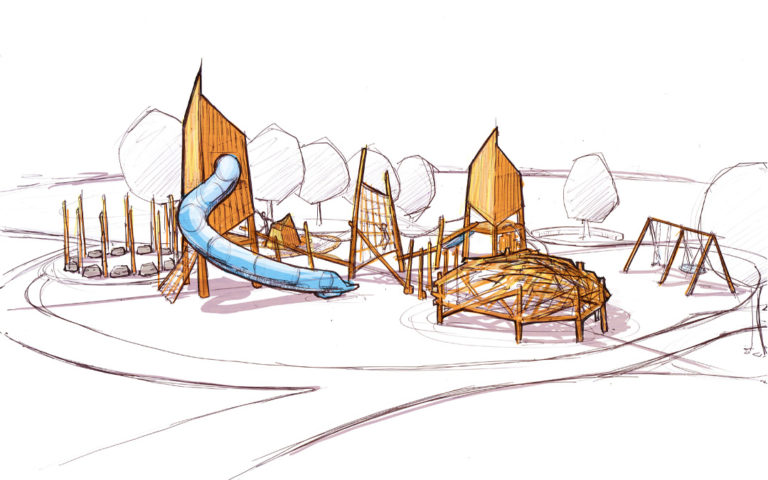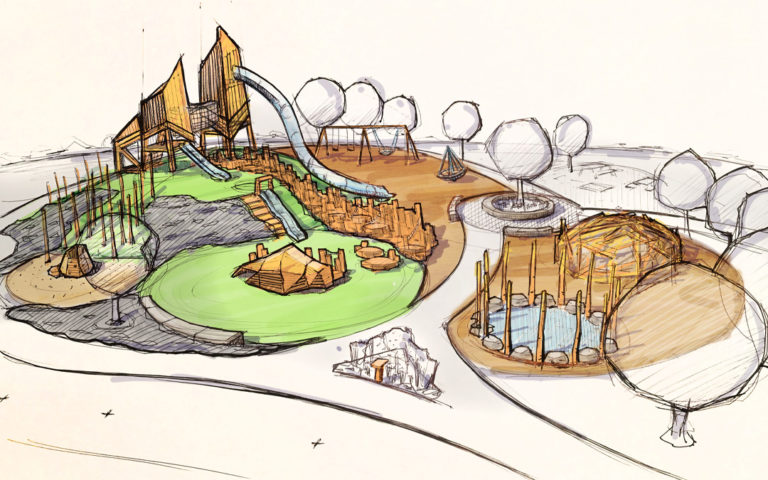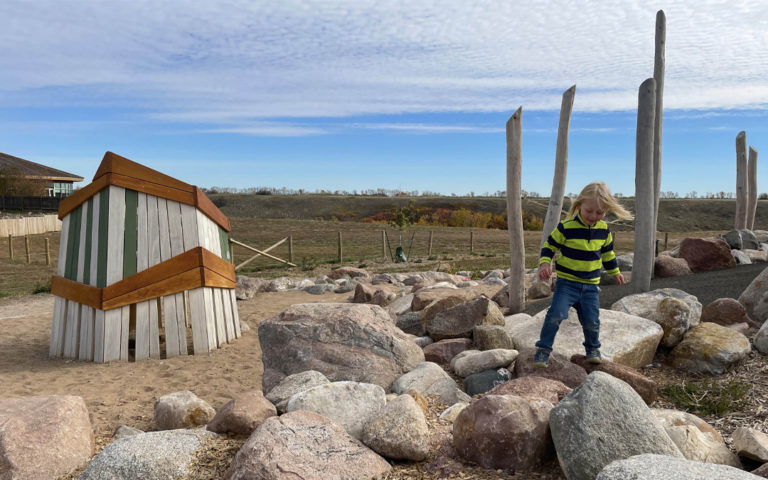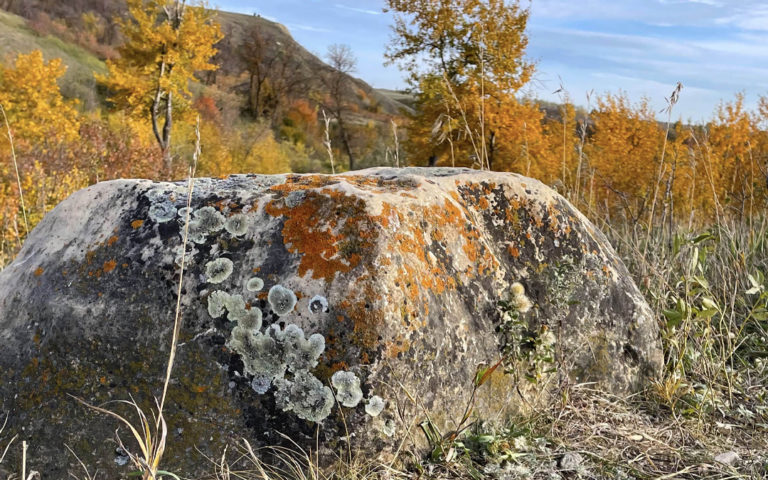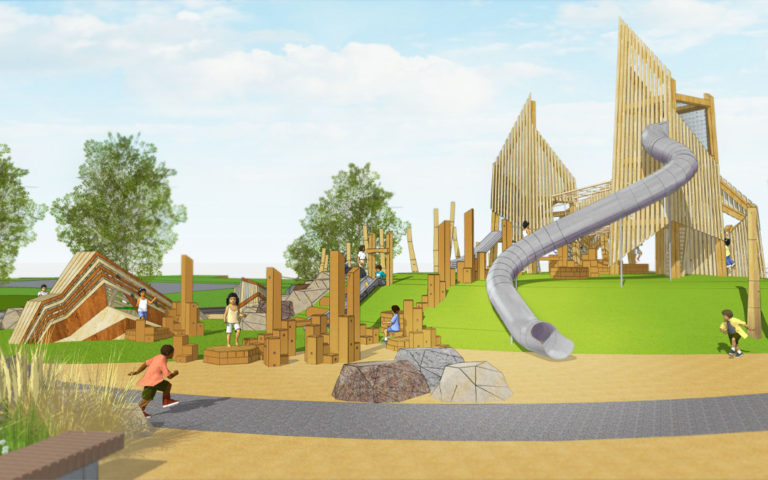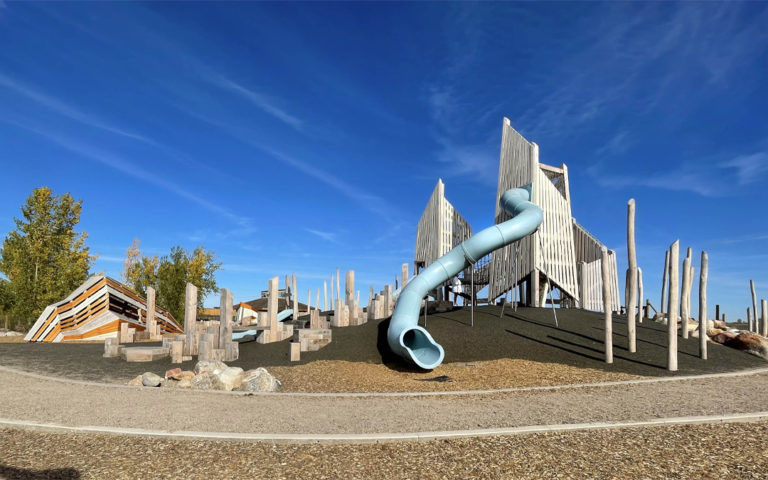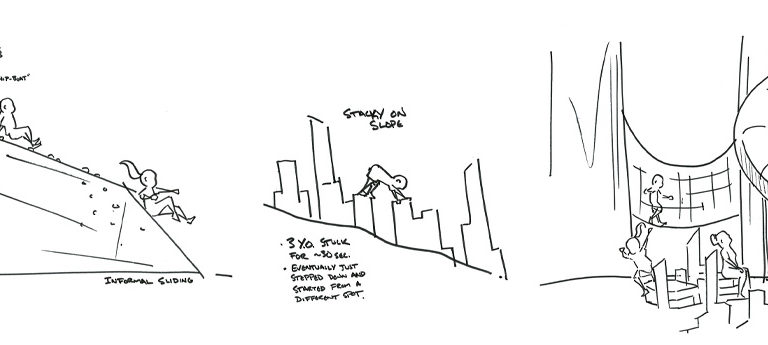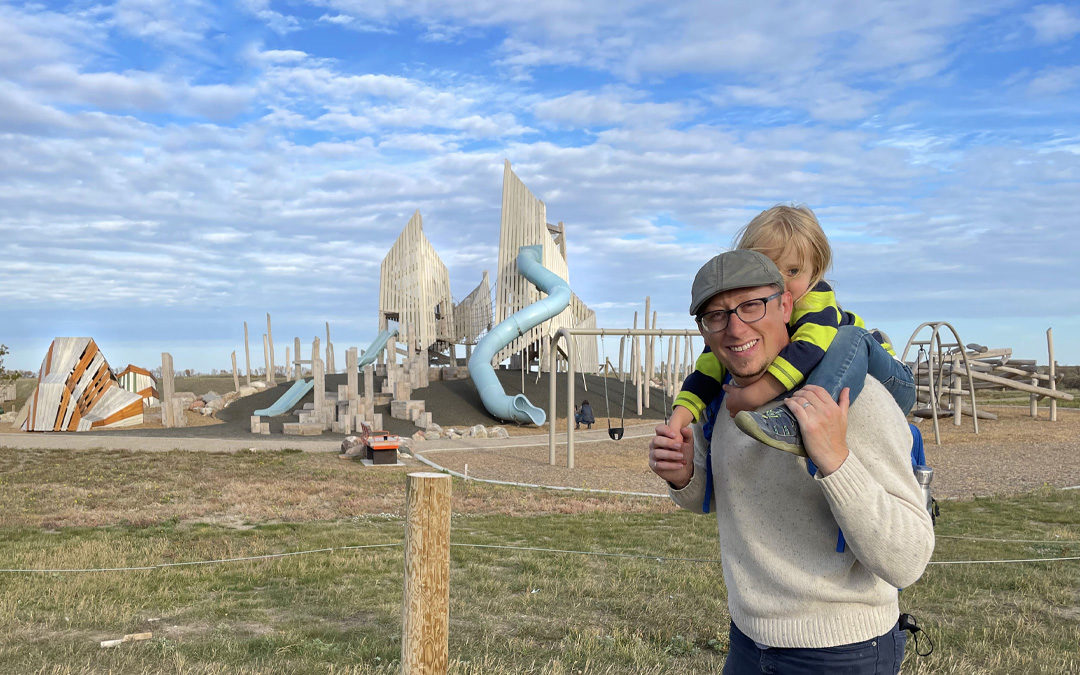
Visiting Wanuskewin: Notes from a Playground Designer
The Wanuskewin Heritage Park (WHP) project wrapped up almost two years ago. Last month, my family crossed Canada to visit this spectacular site. I am convinced it could be the most stunning play space in the world.
Here are a few stories from my work on this project. – Nathan Schleicher
Chapter 1: Excerpts from Nathan’s Diary, December 2017
Scene I: I’ve been working at Earthscape, and living in Canada, for almost 3 months. I am walking home one morning from dropping my son off at kindergarten.
*Ring, Ring*
“Nathan, someone needs to go to Saskatchewan today for a design kickoff meeting. I can pick you up in about 3 hours.”
“Um, ok?”
Scene II: 3 hours later. *Knock, Knock*
“Nathan, do you have anything warmer you can bring?”
Scene III: It is the next day at dawn. The sun doesn’t rise until 9am local time in Saskatoon in December. The landscape architect we are collaborating from Crosby Hanna and Associates has found some warm accessories in the lost & found for me to wear so we can walk about 4km of snow covered trails. I am wearing three pairs of socks and my hat looks like a bunny.
Chapter 2: Site Visit Lessons
- The playground area will be adjacent to a building that looks abstractly shaped like a bison. The building is a museum, archeological lab, art gallery, restaurant and gathering space.
- Until 130 years ago, 26+ million bison roamed North America. White people tried to wipe them out. Less than 1000 bison remained.
- Bison are a keystone species in North America. The Wanuskewin site had been used as a Bison Run for at least 6,400 years. It was likely a Mastodon Run too.
- At least seven First Nations groups have had a presence on the Wanuskewin site over thousands of years. It will be a challenge to balance the symbols and stories from these different Nations and cultures.
- As an American, I have learned that there is an incredibly complex and sad history of Indigenous and European people in Canada. Wanuskewin Heritage Park is so much more than an archeological site. It is a conservation effort for Bison restoration and is a place of reconciliation and learning between all people. However possible, the playground must support that mission. It should tell the story of the land, and create opportunities for storytelling moments between staff and students; elders and children.
- I have learned that, as a designer, there is no replacement for physically visiting a place and its people.
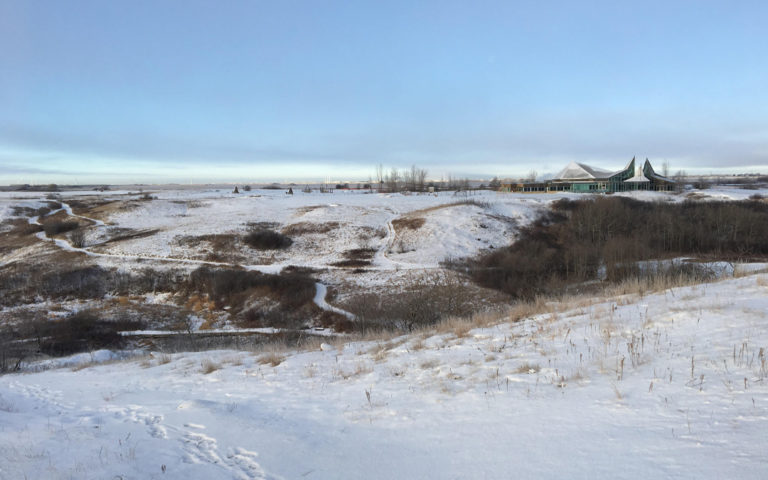
If you look closely, you may see two small teepees just left of center. This will be the location of the playground.
Chapter 3: Getting Started
For the full duration of the flight home, I wrote and sketched ideas. Earthscape was tasked with delivering two concepts in two budget ranges. I learned how expensive solid wood Stacky-Stack (a cousin to Van Eyck’s climbers) can get if you put hundreds of them in your plan…
Chapter 4: Structure Stories
Multiple structures are proposed for the design. Each piece is purposeful in its representation of significant site features and/or history. Simultaneously, each has layered meaning, just as the site history is layered with stories, experiences and change:
- The playground towers take cues from the bison hump and horn-looking architecture of the main building at Wanuskewin. Why four tower structures? Four is a sacred number linked to many Nations’ stories of the four stages of human life. These are typically oriented to the compass directions. The tallest of the four towers is intentionally designed to offer views to the valley behind and the Saskatchewan River.
- The sides of the valley are scattered with glacial rocks. We’ve told this story with Stacky-Stack (hexagonal solid wood steppers and decks) as well as actual stones sourced from the site during construction.
- On the far side of the valley is a lone 4 foot tall boulder. For thousands of years it was made smoother on one side by the bison who came by for a good scratch. Our take on The Rubbing Rock is an angular sculpture in the sand area. The accent colors of deep orange and muted green take their cues from the moss and lichens found on the glacial stones in the valley.
- What is the story of the big log climber? Introduced about 500 years ago, the valley is now home to several beavers. These relative newcomers have a place in the design story in the form of a high challenge climber that looks like a macro-scale dam. The circular footprint of this Log Jam also creates an affordance for groups to gather on top or underneath.
- A more formal gathering circle is created with 13 robinia posts spaced with stone seating in between each. These connect to another sacred number related to stories of the moon and creation. Many traditional rhythms and dances have a sequence of 7 or 13 steps.
- What is the sculpture in the foreground? When I was on-site, I heard some children call it a Ship-Boat or a Big House. There is no right or wrong answer – children’s imaginations can create their own stories. When I look at the form, I think of two stories. One sees a matriarch bison with a young calf at her side. The second imagines warriors (typically a youth around 15 years of age) draped in a bison cloak to trick the herd into thinking they are wayward calves. They would lead the group toward the cairns which are stone markers that indicate a path to the cliff. As the herd gets closer, women would jump out from behind the cairns, waving and making noise to cause a stampede.
Chapter 5: What I experienced on my visit
First Impressions: No playground has an approach as dramatic as this one. The Saskatchewan sky feels bigger and bluer somehow and the playground towers burst up into that sky. In this space, you are compelled to constantly look up. It is also impossible to see everything from any one vantage. Visitors must explore for the space to fully reveal itself.
Play Observations:
- The slide is by far the biggest thrill and kids scream with joy as they swoosh down. It is likely the tallest slide in the province and all ages love it. Two out of three parents went down. A group of 16-18 year old girls came at the end of the day just to play on the slide.
- This is not a neighborhood playground. It is a destination. It is a 15-20 minute drive to Wanuskewin from Saskatoon. I noticed one family had biked there just for the playground.
- I noticed one mom filming a playground review for social media.
- The bison hump sculpture and the Log Jam attracted a lot of attention from groups of older children; children often not seen at your typical playground. These were also the main picture-taking spots.
- All ages liked the Stacky-Stack on the hill slope but younger kids stayed here to play the longest. My son Olen (age 3) often got stuck in a downward-facing-dog pose between two clusters. I helped him get unstuck the first time. The second time I waited 30 seconds and he figured it out.
- All ages love the rope bridge which is more flexible and kinetic than many bridges I have seen. Older kids (about 12-14 years old) can impressively scale it from the outside.
- When not playing, adults gravitated to sitting on the large hexagonal pieces at the top of the Stacky-Stack scramble. The area is well shaded by the tower and slide and in the middle of the action.
- Little kids love scrambling on all of the stones. I found quite a few boulders that kids had rolled from the landscaping into the rubbing rock structure to use as building materials. This probably freaks out the landscape architect but I appreciate the unintended loose parts play!
- Several parents noted that they love that all ages can enjoy the space and that there is just so much for everyone. At least three families were there for the entire afternoon and the average visit exceeded an hour.
Chapter 6: Departing Thoughts
It was incredibly meaningful to visit, and to witness the joy and wonder the space can inspire. When I stepped off the plane in Saskatoon four years ago the landscape architect told me, “This might be the most important project in my life. I may never get to do something like this again.” I now understand that feeling. As a designer it has been an outstanding and humbling opportunity to creatively respond to the deep richness of history, culture, and beauty present at Wanuskewin.

